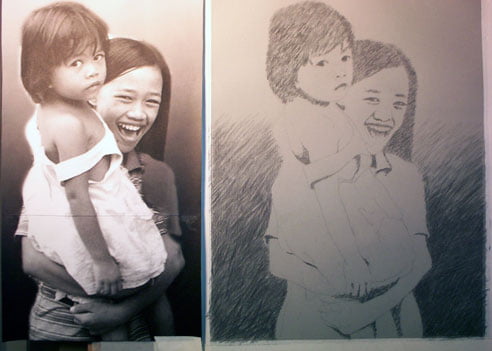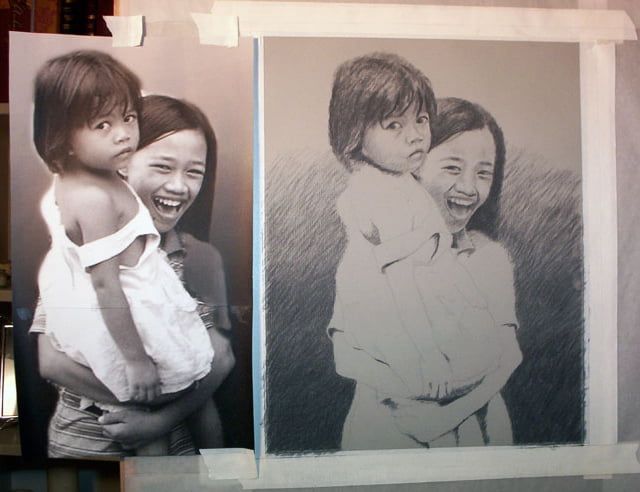Picking Up Where I Left Off
Greetings to you, my faithful readers! Being on vacation for the past week (ah, so nice…), I wanted to take some time tonight to put up a short post since I haven’t done so in a while. Before I left, I had done about 2 hours worth of work on the drawing from my previous post. This is the first drawing I’ve ever done completely in vine charcoal, so I’ve been putting all of my acquired book-knowledge to practical use. As with many things, however, there is no better teacher than experience and I’ve learned quite a bit about the performance of the charcoal since I’ve begun – some good things, and some annoying things…
Following the advice from some of the books I’ve read on the subject, I began the drawing by laying in the darkest darks with soft vine charcoal. Windsor & Newton carries four densities of vine charcoal – hard, medium, soft, and extra-soft. I began with extra-soft, but soon gave it up because of the frequency of which it needed to be re-sharpened. It was only possible to make a few marks or lines on the paper before the tip would disappear, sacrificing the control I had over the marks I was making. I had a much better go of it with the regular soft charcoal.

Since my background is to be very dark towards the bottom of the picture, I began building up these darks first. The strokes of charcoal were laid down in one direction – not back and forth like I would normally do with pencil. The first thing I noticed in building up dark areas was the saturation of charcoal on the paper. It’s essential to blow off the excess charcoal every once and a while and then continue building up the darks. After what seemed like an eternity, I had most of the background filled in with a first-layer of charcoal. I was a little concerned because it didn’t look especially pretty… The charcoal marks kind of looked like a rat’s nest of lines. Given time and patience building up layers, however, I see that the individual marks begin to disappear and the dark areas become more unified. Varying the angle of the charcoal strokes also helps to fill in some of the uncoated paper as well.
Next, I continued using my soft charcoal to fill in the darkest shadows of the picture. While doing this, I found that I had to make many critical decisions along the way. There were certain areas that seemed fairly dark, but I tried to only use the soft charcoal on the absolute darkest shadows, as I feel that I will have more control if I build some of the other shadows up slowly with medium or hard charcoal.
Getting Down to the Nitty Gritty
Last night I began my second drawing session with medium-density vine charcoal. I had a slight bit of disappointment with it. When trying to lay in some of the mid-tone shadows, I noticed that it went down much darker than I had anticipated. Not only that, but it was actually difficult to keep light – even when applying very little pressure. After adding some into the background gradient, I decided to try out the hard charcoal on the faces, as I didn’t want to work on them without feeling like I had sufficient control over my materials.
I noticed almost the exact opposite problem with the hard charcoal. While it maintains it’s tip for quite some time, I found that it was difficult to get a consistent line. Being mindful not to damage my paper, I tried not to use too much pressure. Sometimes I would hit a “sweet spot” on the charcoal stick that would give me consistent lines for a while, and then I would hit a hard spot that didn’t seem to lay down anything. I’m using a mahl stick to steady my hand while I draw, and I especially noticed this problem with it because of the angle that the charcoal touches the paper – a little more perpendicular than when drawing freehand. Some thoughts that I’ve had regarding this are that it could be the irregularities of the individual charcoal sticks. I suppose that some of them could be harder or softer than others, but generally classified into W&N’s four densities. After all – this is burnt wood we’re talking about here… I would imagine there has to be some variance from time to time. Also, I would like to try vine charcoal produced by some other manufacturers and compare/contrast a bit, too.

Regardless of difficulties, I managed to get some detail work done on the faces in about two hours worth of drawing time. Before I do any more work on them, I need to go over the rest of the surface so as to not over-develop any one area of the drawing at once. A drawing must be brought slowly and consistently throughout the whole picture. More coming soon…